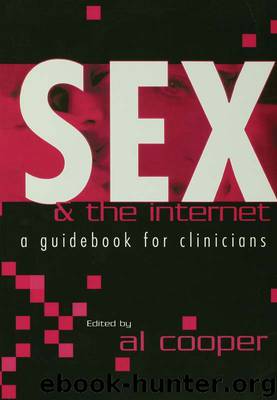Sex and the Internet by Cooper Al

Author:Cooper, Al
Language: eng
Format: epub, mobi
ISBN: 978-1-135-45088-5
Publisher: Taylor and Francis
8
CHAPTER David L. Delmonico
Elizabeth Griffin
Patrick J. Carnes
Treating Online Compulsive Sexual Behavior: When Cybersex Is the Drug of Choice
Introduction
An estimated 90 million people use the Internet each month, a number that has rapidly increased and continues to rise. In addition to the more than 100 billion homepages, there are innumerable chatrooms, newsgroups, and e-mails. What was once used by the U.S. Department of Defense, has become a medium for research, communication, and, for some, a venue for online sexual activity.
Just as the use of the Internet has increased dramatically over the past 10 years, so has the interest in studying the phenomena associated with this microcosm of the world. Research regarding sexual behavior has also been of great interest in Western culture. Perhaps it is not serendipitous, then, that these two fields have come together to form a new area of research and treatment: cybersex. Cybersex creates a virtual world in which participants can be whomever they wish, engage in erotic behaviors, and live out fantasies that could never before be realized. Although not everyone is negatively impacted by cybersex, researchers such as Carnes, Cooper, Delmonico, Griffin, Putnam, and Young study individuals who have jeopardized everything so that they may engage in cybersex.
Cybersex users continue to perplex researchers and clinicians with the depth and breadth of their online behavior. This chapter explores and explains how some individuals become obsessed with sexuality on the Internet and the treatment strategies that may be employed to help them with their compulsive behavior. The focus of this chapter is on helping those who appear to be sexually lost in cyberspace: the cybersex compulsive.
Understanding Cybersex Compulsivity
Schneider (1994) set forth three necessary and rudimentary criteria to screen a behavior as addictive/compulsive: (a) loss of freedom to choose whether or not to engage in a behavior (compulsivity); (b) continuation of the behavior despite adverse consequences related to the behavior (consequences); and (c) obsession with the behavior. Although Schneider's criteria are broad, they help define the basic aspects of a process addiction, a compulsive behavior that does not include the ingestion of substances. Schneider also suggested that the criteria for pathological gambling (American Psychiatric Association [APA], 1994) serves as an analogy for other process addictions, pointing to the fact that even substance abuse criteria are primarily behaviorally based. If certain behaviors such as gambling can be considered pathological, could it not also be true that other behaviors, such as cybersex, may be considered pathological if they meet specific diagnostic criteria?
Download
This site does not store any files on its server. We only index and link to content provided by other sites. Please contact the content providers to delete copyright contents if any and email us, we'll remove relevant links or contents immediately.
Should I Stay or Should I Go? by Ramani Durvasula(7430)
Why We Sleep: Unlocking the Power of Sleep and Dreams by Matthew Walker(6357)
Fear by Osho(4495)
Flow by Mihaly Csikszentmihalyi(4491)
Rising Strong by Brene Brown(4192)
Why We Sleep by Matthew Walker(4190)
How to Change Your Mind by Michael Pollan(4112)
Too Much and Not the Mood by Durga Chew-Bose(4095)
The Hacking of the American Mind by Robert H. Lustig(4086)
Lost Connections by Johann Hari(3922)
He's Just Not That Into You by Greg Behrendt & Liz Tuccillo(3713)
Evolve Your Brain by Joe Dispenza(3504)
The Courage to Be Disliked by Ichiro Kishimi & Fumitake Koga(3256)
Crazy Is My Superpower by A.J. Mendez Brooks(3204)
What If This Were Enough? by Heather Havrilesky(3198)
Resisting Happiness by Matthew Kelly(3194)
Descartes' Error by Antonio Damasio(3166)
The Book of Human Emotions by Tiffany Watt Smith(3141)
In Cold Blood by Truman Capote(3136)
